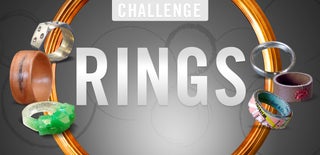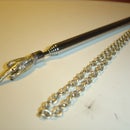Introduction: Mechanical Claw Ring
This Instructable will teach you how to make a wearable, fully functional robotic claw, attached to a ring. It's purpose, besides it being interesting and beautiful, is to make it possible to pick up a new object while something is already clasped in the hand. The claw is fully operable with just the thumb.
The ring and mechanism's design is by me.
Step 1: Diagrams: How It Works
There are several mechanisms that make up this ring: the gripper, the bellcrank, and two pistons. The gripper mechanism is opened and closed with the reciprocation of a piston, which pushes the gripper open, and pulls it closed. The bellcrank allows for the second piston to drive the gripper from a perpendicular angle, so that the claw can be operated with the thumb while the ring is on the hand.
This instructable shows how to make this ring for the right hand, but the plans and assembly could easily be flipped to fit the left hand.
Step 2: Parts and Tools
Parts:
- Various Brass strips and tubes:
- Brass rectangular tube 3/32x3/16 (like sold here)
Brass C-Channel (1/8"x1/16"x.020") (here)
- Lead-free solder
- Small watch-case screws, that fit loosely into a 1/16" hole (10)
- (5) Plain, flat, silver plated brass, 2-hole spacer bars (like here, though you don't need nearly that many, and can buy them in fewer quantities at craft stores) (they don't have to be silver plated, but they have to be a solderable metal)
Tools and Supplies:
- Dremel with:
- Diamond cutoff bit
- Polishing bits
- Drill with:
1/16" Drill bit
- Pickel bath (home-made one needs 1 cup vinegar, 1 tbsp salt, and crockpot or a non-metal container on a heat source)
- 1000 grain all-use sandpaper
- Butane torch and/or soldering iron (I recommend a small to medium butane torch, but I did not have one myself, so I had to use my soldering iron, which was much more difficult to use than a torch would have been)
- Brick, or other fireproof surface for soldering
- Ruler (metric)
- Various small metal files
- Polishing compound
- Soldering Flux
- Tweezers and pliers
- Superglue
- Small shop brush
- Pencil
- Small hammer
Step 3: Cut and Arrange the Parts
There will be three basic components to this ring: the gripper, the bellcrank component, and the ring. I will refer to these components throughout the instructable to explain what is being assembled.
These are the measurements for the pieces that need to be cut:
From the brass rectangular tube:
- 15 mm (the crankshaft attached to the gripper)
- 6 mm (the crankshaft attached to the bellcrank component)
From the brass C-Channel:
- (2) 24 mm (the two grippers)
- 33 mm (the primary vertical reciprocating piston)
- (2) 16 mm (the lower arms of the gripper)
- 27 mm (the connection between the gripper and the bellcrank component)
- 24 mm (the lower horizontal reciprocating piston
Cut from flat sheet metal:
- 10mm x 30mm flat brass (the base for the gripper)
- 13mm x 25mm (the base for the bell crankcomponent
The flat spacers:
- 7 total
- 4 attached only with screws
- 2 soldered together perpendicularly, with one of each of their holes overlapping
- 1 soldered to the primary vertical reciprocating piston
Cut from 6mm height bar of metal:
- Cut to fit ring size of wearer
Other:
- The bell shafts primary axle rivet is cut after it is soldered into place on the bellcrank component
- 10 watch-case screws to act as the rivets and axles for the moving parts attachment to each other
Step 4: Solder
This step would be highly simplified with a proper butane torch, but can be done (and was done by me) with a 40w or above soldering iron. The iron has to touch as much of the metal being soldered as possible, and will have to be held in place for several seconds before the metal is hot enough to melt the solder. Always melt the solder with the metal components, and not the soldering iron. To keep the metal components in place after the soldering iron is removed, hold the metal in place with tweezers or a soldering aid tool until the solder cools.
Step One: Solder a 2-hole spacer to the end of the primary vertical reciprocating shaft, like in the pictures.
Step Two: Then, solder the parts of the gripper together. See the pictures to find the position for each meta piece as they fit on the sheet metal for the gripper. The solder should fit under the c-channel parts, and on top of the sheet metal for the gripper. For the hollow rectangular shaft (the piece in the very middle), place the solder to the right of the piece, opposite to the side next to the metal piece that connects the gripper to the bellcrank component.
Step Three: Next, solder the piece of rectangular tube that attaches to the sheet metal for the bellcrank component. It attaches to the lower left of the bellcrank component. The solder should go next the rectangular tube, and be careful not the fill the tube with any solder. This is the bellcrank mechanism's rotating crank. This is attached to the bellcrank component the rivet, soldered on at the end of this step.
Step Four: Next, solder together two perpendicular 2-hole spacers, so that one hole on each spacer overlaps with the other spacer's hole. Solder the outside of the joint, being careful not to fill any holes.
Step Five: Finally, drill a hole with a 1/16" drill bit through the lower end of the tip of the c-channel rod that connects the gripper to the bellcrank component, and the bellcrank sheetmetal where the c-channel rod will connect to it -- this is the corner above and opposite the piece of rectangular tube soldered onto the bellcrank component earlier. Insert the cylindcal tubing for the rivet into the hold, until it is flush with the bottom of the sheetmetal piece. Solder all these parts together at this join. Be careful not to remelt the previously soldered parts. Make sure the bellcrank's rotating crank fits over the rivet, and cut the tubing.
Step 5: Pickle and Polish
The point of a metal pickle is to wash away the melted flux and any stains caused by the soldering process.
I made a pickel out of 1 cup vinegar, and a heaping tablespoon of salt. I heated the vinegar on a hotplate in a heatproof pyrex measuring cup, and mixed in the salt once the vinegar started to simmer. I found this perfectly good enough, but a store bought pickle would be stronger, and work faster. Use whatever you think is best here. Use a wood spoon to remove the metal to avoid compromising the pickle.
Rinse the metal in water, and dry. Finally, polish the metal with a polishing bit, polishing compound, and dremel. The metal can be polished again after the parts are assembled, but the screws will get in the way of a thorough polish later.
Step 6: Drill Holes
There are a total of 8 holes that need to be drilled, all with a 1/16" drill bit. The first hole was already drilled in the soldering step. The other 7 holes need to be drilled now. To keep the drill bit in place while drilling, it's a good idea to take a nail, and gently hammer a dent where you are going to drill the hole.
Gently sand the holes clean of stray metal.
Step 7: Assemble Moving Parts With Screws
Assemble the moving parts in the order seen in the pictures: first, slide in the piston that attaches to the gripper. Then, attache the the bellcrank's crank and the gripper arms. Glue the screws into place and let dry. Then the 2-hole spacers that attach the gripper arms to the gripper component. Glue the screws into place and let dry. Then last, slide the piston into its crankshaft in the bellcrank mechanism, and attach the 2-hole spacers that act as connector rods for the bellcrank. Glue the screws into place and let dry.
The screws will fit into the holes fairly loosely, so the joints can move. The other side of the screws, once they are put into place in the holes, need to be glued in place with a tiny drop of superglue. To superglue screws that would fall out if the claw were flipped over, use a toothpick to dab a tiny drop of glue on the nail. The glue can touch the bottom side of the metal that the bottom of the screw comes out from, but not the piece of metal on top, or the joint wont move.
Step 8: Shape and Solder Ring
Bend and hammer around a cylindrical shape the 6mm brass bar until its circumference is the ring size you want. Cut off any extra brass. File flat and clean the ends of the bar, and fit the ends together. Finally, solder the ends toghether.
Step 9: Attach Claw to Ring
Solder the ring to the middle of the back of the bellcrank component, being careful to not melt any of the solder already used on the bellcrank mechanism.
Step 10: Final Polish
Even if you polished the metal before assembling, it's a good idea to finish it off with another polish now. Some of the work done in the meantime may have marred the surface.
Step 11: Wear and Grab Things
Wear on the index finger, so that the mechanism can reach the thumb, and the claw can rest on your other fingers.
(NOTE: I am fully aware I have not attached anything that the thumb can fit in, to operate the claw, yet. I will get to that soon, and add it to the Instructable when I am done.)
----------------------------
Please vote for me in the Rings Challenge!
Look at my tools. I have no tools. I don't even have a butane torch. Did you see my pliers? They are so sad and dull, I really need some new tools.

First Prize in the
Rings Challenge

Participated in the
Burn It! Contest













